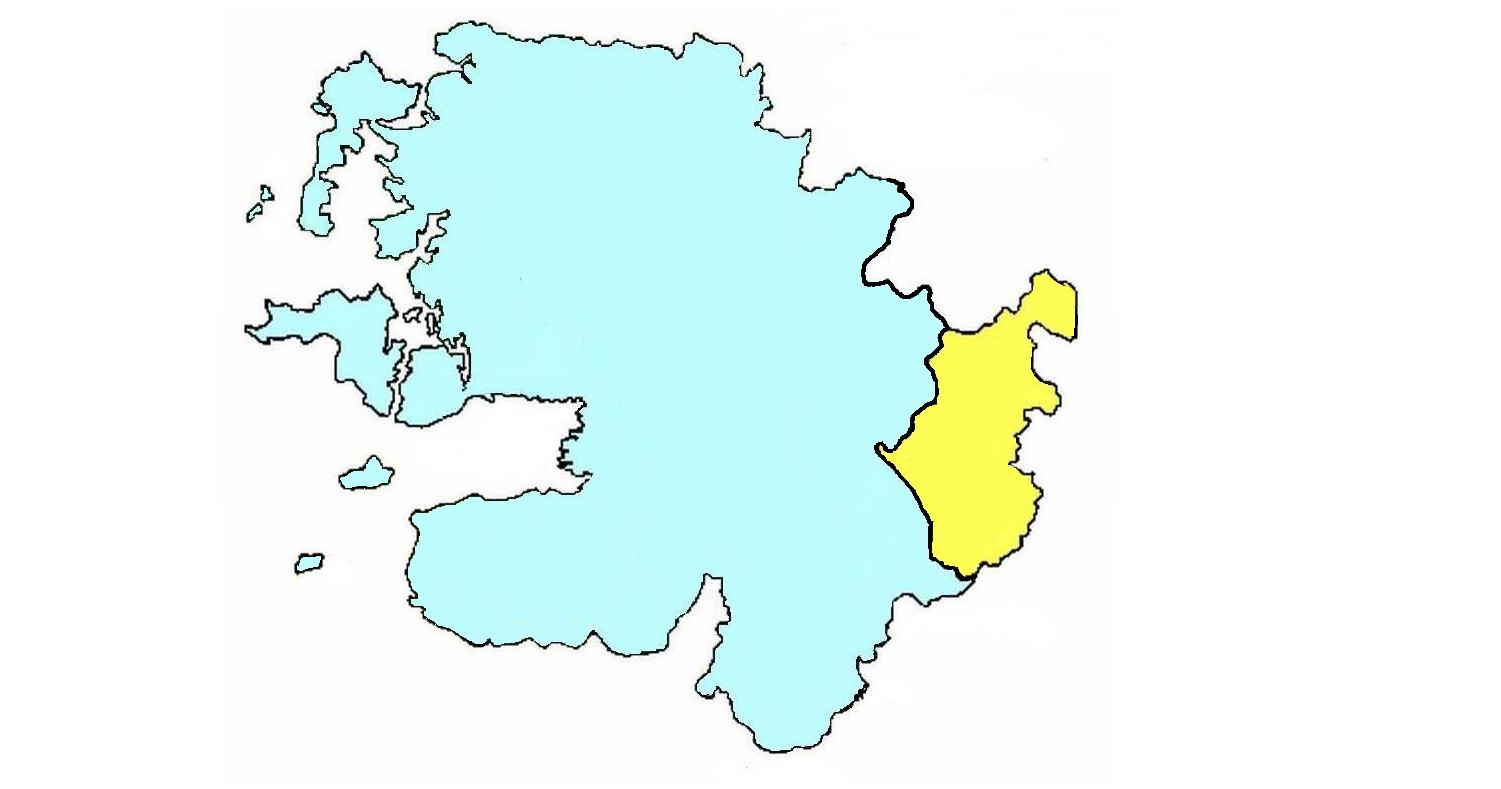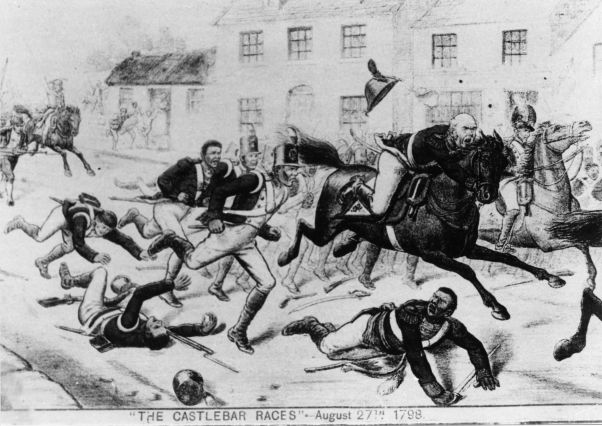|
Kilmovee
Kilmovee () is a village and civil parish in County Mayo, Ireland. It is a mainly rural parish on the R325 road, midway between Kilkelly and Ballaghaderreen. In March 2004, the Cois Tine Heritage Centre was opened and since then it has become a cultural centre for the people of the area. In 2011, the Annual Seosamh Mac Gabhann Summer School was established in Kilmovee to honour the Irish language playwright and music teacher Seosamh Mac Gabhann, who lived and worked in Kilmovee for much of his life. History In pre-Norman Ireland, the lands of Kilmovee formed part of the Kingdom of Sliabh Lugha, a territory ruled by the O'Gadhra Dynasty. Sliabh Lugha was a subdivision of the larger Gailenga kingdom, from which derives the modern name Gallen. After the Norman Invasion, the parish of Kilmovee became part of the Barony of Costello. The Nangle or de Angelo invaders came southwest from the De Lacy territory in Carrick-on-Shannon and forced the O'Gadhras from their stronghold in ... [...More Info...] [...Related Items...] OR: [Wikipedia] [Google] [Baidu] |
Kilcashel Stone Fort
Kilcashel Stone Fort is a double court cairn and National Monument located in County Mayo, Ireland, 800m (½ mile) southeast of Kilmovee. The last surviving member of three stone forts in the area, it's estimated to have been constructed between 2,500 and 500BC. Description Kilcashel Stone Fort is in diameter; the stone wall is thick and in height. A souterrain is located inside, as well as a bullaun A bullaun ( ga, bullán; from a word cognate with "bowl" and French ''bol'') is the term used for the depression in a stone which is often water filled. Natural rounded boulders or pebbles may sit in the bullaun. The size of the bullaun is high ... and the sites of two collapsed houses. References {{Reflist National monuments in County Mayo Archaeological sites in County Mayo ... [...More Info...] [...Related Items...] OR: [Wikipedia] [Google] [Baidu] |
Barony Of Costello
CostelloCostello Placenames Database of Ireland. Retrieved: 2012-04-25. is one of the ancient . Unusually for an barony, it straddles two : and . It com ... [...More Info...] [...Related Items...] OR: [Wikipedia] [Google] [Baidu] |
R325 Road (Ireland)
The R325 road is a regional road in County Mayo and County Roscommon in Ireland. It connects the N83 and N17 roads at Glentavraun near Knock Airport in County Mayo to the R361 at Cloonarragh near Castlerea in County Roscommon, away (). ''Irish Statute Book'' (irishstatutebook.ie), 2013-02-27. The government legislation that defines the R325, the ''Roads Act 1993 (Classification of Regional Roads) Order 2012 (Statutory Instrument 54 of 2012)'', provides the following official description: :Glentavraun, County Mayo — Cloonarragh, County Roscommon :Between its junction with N83 at Glentavraun in the county of Mayo and its junction with [...More Info...] [...Related Items...] OR: [Wikipedia] [Google] [Baidu] |
Ring Fort
Ringforts, ring forts or ring fortresses are circular fortified settlements that were mostly built during the Bronze Age up to about the year 1000. They are found in Northern Europe, especially in Ireland. There are also many in South Wales and in Cornwall, where they are called rounds. Ringforts come in many sizes and may be made of stone or earth. Earthen ringforts would have been marked by a circular rampart (a bank and ditch), often with a stakewall. Both stone and earthen ringforts would generally have had at least one building inside. Distribution Ireland In Irish language sources they are known by a number of names: ' (anglicised ''rath'', also Welsh ''rath''), ' (anglicised ''lis''; cognate with Cornish '), ' (anglicised ''cashel''), ' (anglicised ''caher'' or ''cahir''; cognate with Welsh ', Cornish and Breton ') and ' (anglicised ''dun'' or ''doon''; cognate with Welsh and Cornish ').Edwards, Nancy. ''The Archaeology of Early Medieval Ireland''. Routledge, 20 ... [...More Info...] [...Related Items...] OR: [Wikipedia] [Google] [Baidu] |
Irish Language
Irish ( Standard Irish: ), also known as Gaelic, is a Goidelic language of the Insular Celtic branch of the Celtic language family, which is a part of the Indo-European language family. Irish is indigenous to the island of Ireland and was the population's first language until the 19th century, when English gradually became dominant, particularly in the last decades of the century. Irish is still spoken as a first language in a small number of areas of certain counties such as Cork, Donegal, Galway, and Kerry, as well as smaller areas of counties Mayo, Meath, and Waterford. It is also spoken by a larger group of habitual but non-traditional speakers, mostly in urban areas where the majority are second-language speakers. Daily users in Ireland outside the education system number around 73,000 (1.5%), and the total number of persons (aged 3 and over) who claimed they could speak Irish in April 2016 was 1,761,420, representing 39.8% of respondents. For most of recorded ... [...More Info...] [...Related Items...] OR: [Wikipedia] [Google] [Baidu] |
Iron Age
The Iron Age is the final epoch of the three-age division of the prehistory and protohistory of humanity. It was preceded by the Stone Age (Paleolithic, Mesolithic, Neolithic) and the Bronze Age (Chalcolithic). The concept has been mostly applied to Iron Age Europe and the Ancient Near East, but also, by analogy, to other parts of the Old World. The duration of the Iron Age varies depending on the region under consideration. It is defined by archaeological convention. The "Iron Age" begins locally when the production of iron or steel has advanced to the point where iron tools and weapons replace their bronze equivalents in common use. In the Ancient Near East, this transition took place in the wake of the Bronze Age collapse, in the 12th century BC. The technology soon spread throughout the Mediterranean Basin region and to South Asia (Iron Age in India) between the 12th and 11th century BC. Its further spread to Central Asia, Eastern Europe, and Central Europe is somewhat dela ... [...More Info...] [...Related Items...] OR: [Wikipedia] [Google] [Baidu] |
Ogham
Ogham (Modern Irish: ; mga, ogum, ogom, later mga, ogam, label=none ) is an Early Medieval alphabet used primarily to write the early Irish language (in the "orthodox" inscriptions, 4th to 6th centuries AD), and later the Old Irish language (scholastic ogham, 6th to 9th centuries). There are roughly 400 surviving orthodox inscriptions on stone monuments throughout Ireland and western Britain, the bulk of which are in southern Munster. The largest number outside Ireland are in Pembrokeshire, Wales. The vast majority of the inscriptions consist of personal names. According to the High Medieval ''Bríatharogam'', the names of various trees can be ascribed to individual letters. For this reason, ogam is sometimes known as the Celtic tree alphabet. The etymology of the word ''ogam'' or ''ogham'' remains unclear. One possible origin is from the Irish ''og-úaim'' 'point-seam', referring to the seam made by the point of a sharp weapon. Origins It is generally thought that th ... [...More Info...] [...Related Items...] OR: [Wikipedia] [Google] [Baidu] |
Viscount Dillon
Viscount Dillon, of Barony of Costello, Costello-Gallen (barony), Gallen in the County Mayo, County of Mayo, is a title in the Peerage of Ireland. It was created in 1622 for Theobald Dillon, 1st Viscount Dillon, Theobald Dillon, Lord President of Connaught. The Dillons were a Hiberno-Normans, Hiberno-Norman landlord family from the 13th century in a part of County Westmeath called 'Dillon's Country'. His great-grandson, the seventh Viscount, was a supporter of the Catholic James II of England, King James II of England and was outlawed after the Glorious Revolution. He founded 'Dillon Regiment, Dillon's Regiment' of the Irish Brigade (French)#Formation, Irish Brigade in the French Army, which was supported by the Flight of the Wild Geese, Wild Geese and achieved success at Battle of Fontenoy, Fontenoy in 1745. However, his son Henry, the eighth Viscount, managed to obtain a reversal of the outlawry in 1694 and later served as Lord Lieutenant of Roscommon, Lord Lieutenant of Count ... [...More Info...] [...Related Items...] OR: [Wikipedia] [Google] [Baidu] |
Castlemore
Castlemore is suburban area that is located 14 km northeast of downtown Brampton in Ontario, Canada. It consists of multiple neighbourhoods of Brampton northwest of Claireville. The area has been in active development since the early 1990s, with residential developments built in the southeastern portion in the 2000s. It has a number of luxury homes with lots. Castlemore is southwest of Bolton, southeast of Caledon and Orangeville, and west of Vaughan. It is accessible from Highway 427 via Highway 7, and The Gore and the Highway 407 at the Goreway interchange or at Airport Road interchange. The West Humber River flows through the western portion of Castlemore. Geography Farmlands formerly surrounded the centre of Castlemore, whereas forests are the dominant feature in the Etobicoke Creek and the West Humber River valleys, which include the outlying hills and a conservation area to the south. To the north is more farmland. History The larger lots were developed in t ... [...More Info...] [...Related Items...] OR: [Wikipedia] [Google] [Baidu] |
Achonry
Achonry (; ) is a village in County Sligo, Ireland. The old name is Achad Cain Conairi. St. Nath Í ua hEadhra (O'Hara) founded a monastery here. The foundation gave the later diocese its name. The monastery was founded on land granted by the Clan Conaire. Nath Í was the teacher of St. Féichín of Ballysadare. The diocese was co-extensive with the barony of Leyney (Luighne). In the parish is the former Church of Ireland Cathedral of St Crumnathy, now deconsecrated. The title, Bishop of Achonry, takes its name from the village, and has been used by bishoprics in both the Roman Catholic Church and Church of Ireland The Church of Ireland ( ga, Eaglais na hÉireann, ; sco, label= Ulster-Scots, Kirk o Airlann, ) is a Christian church in Ireland and an autonomous province of the Anglican Communion. It is organised on an all-Ireland basis and is the second .... See also * List of towns and villages in Ireland * Feardorcha Ó Conaill (1876–1929), writer and former re ... [...More Info...] [...Related Items...] OR: [Wikipedia] [Google] [Baidu] |
Castlebar
Castlebar () is the county town of County Mayo, Republic of Ireland, Ireland. Developing around a 13th century castle of the de Barry family, de Barry family, from which the town got its name, the town now acts as a social and economic focal point for the surrounding hinterland. With a population of 12,318 in the 2011 census of Ireland, 2011 census (up from 3,698 in the 1911 census of Ireland, 1911 census), Castlebar was one of the fastest growing town in Ireland in the early 21st century. A campus of Atlantic Technological University and the National Museum of Ireland – Country Life, Country Life section of the National Museum are two important facilities in the area. The town is rail transport in Ireland, linked by railway to Dublin, Westport, County Mayo, Westport and Ballina, County Mayo, Ballina. The main route by road is the N5 road (Ireland), N5. History The modern town grew up as a settlement around the de Barry family, de Barry castle, which was built by a Norman ... [...More Info...] [...Related Items...] OR: [Wikipedia] [Google] [Baidu] |

%2C_Co_Roscommon%2C_Ireland.jpg)


_(14760479206).jpg)

